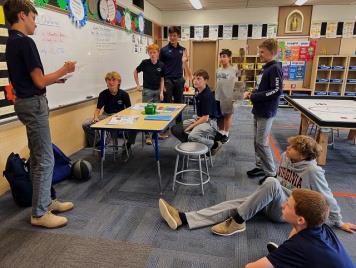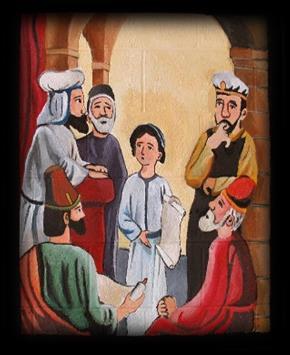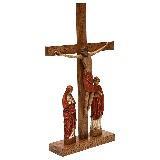
OUR CREATIVE CONTRIBUTORS

Sister Jeanne Baker IHM
Sister Mary Chapman IHM
Joellyn Cicciarelli
Karen Creely
Sister Mary Jo Ely IHM
Victoria Dilks
Sister Theresa Duffy IHM
Sister Judith Kathleen Knowlton IHM
Kim Lamb
Sister Patricia McCormack IHM
Sister Sarah Ellen McGuire IHM
Patricia O’Donnell
Sister Edward William Quinn IHM
Sister Eileen Reilly IHM
Sister Christina Marie Roberts IHM
Sister Stephen Anne Roderiguez IHM
Sister Amanda Marie Russell IHM
Sister Patricia Scanlon IHM
Sister Kathleen Monica Schipani IHM
Sister Monica Therese Sicilia IHM
Sister Eileen Tiernan IHM
Sister Stephanie Gabriel Tracy IHM

Dear Friends,
Welcome to our Spring 2022-2023 issue of the IHM Catholic EdNotes!
Our cover this edition calls attention to LENT! Lent can be a time when we re-connect with ourselves, others, and God’s creation. It’s a time to take a step back and bring a new focus of virtue to our everyday lives. This issue shares several resources to enhance your personal Lenten journey as well as your best practices as a Catholic educator.
Our IHM Sisters and our dedicated lay colleagues, recognize the centrality of our faith and its place in our everyday lives. Cultivating a spiritual life strengthens our ability and that of our students to engage more attentively in life, individually and as a member of community. We have our faith to support our daily energy level and focus as we navigate the opportunities to grow in grace that we and our students may encounter.
We hope to inspire and assist you with the sacred work of Catholic education through these interesting and informative features, whether in a catechetical parish program or a Catholic school setting Pre-K through Grade 12.
If you have any comments or suggestions, please contact us: ihmcatholicednotes@gmail.com

God bless you for your dedication to Catholic education!

What The World Needs Now, Love Sweet Love
You may remember the poignant and still relevant aspirations of a song that became popular in the late 1960s - What the World Needs Now : What the world needs now is love, sweet love
It's the only thing that there's just too little of What the world needs now is love, sweet love

No not just for some, but for everyone.
In more recent times, Pope Francis has given us a well-defined blueprint that clearly expresses the sentiments of this timeless song – what the world needs now - in what he describes as the culture of encounter. Pope Francis tells us: “For me this is very important. Encounter with others. Why? Because faith is an encounter with Jesus, and we must do what Jesus does: encounter others. To generate a culture of encounter means not just seeing, but looking; not just hearing, but listening; not just passing people by, but stopping with them; not just saying at times “what a shame, poor people”, but allowing yourself to be moved with compassion.” Such encounters move us to action, to service that “always looks to their faces, touches their flesh, senses their closeness… (Fratelli Tutti, #115) Obviously, this is foundational to Pope Francis’ riveting plea communicated in Laudato Si’ – care for our common home and care for one another, especially the most vulnerable. Yes. What the world needs now is love, sweet love.
Most likely, this unique vision of such a culture of encounter had its place in the many conversations between Father Louis Gillet and Mother Theresa Maxis, the IHM Sisters’ Co-Founders, that eventually moved Theresa with imagination and courage to journey to Monroe, Michigan and with her companions to begin the first IHM mission to God’s people in 1845. There have been since then thousands of IHM Sisters who, as joyful bearers of God’s redeeming love, alongside their devoted lay colleagues, have contributed to the creating of cultures of encounter wherever they have served and continue to serve today.
Faithful Witness, our IHM Sisters’ rule of life, offers this description of our chosen way of being among God’s people, affirming our embrace of a culture of encounter: “The mission of the Church encompasses people of varying races, languages, cultures, and social circumstances; therefore, each sister in her evangelizing efforts is ever receptive in spirit and responsive in action to all persons she meets (#42.2)”. And further, we commit: “In each person she meets, a sister sees a child of God…aware of this, she will treat each person with understanding, gentleness, and compassionate love (Faithful Servant, #44). This describes more than ever what the world needs now, love, sweet love! Maya Angelou articulates for us the very heart of the matter: “Your legacy is every life you’ve touched”. Choose the touch of love! Yes! What the world needs now is love, sweet love!
Mindful Educator: What’s Your Story?
There once was a teacher who sat in front of her curriculum, thinking, “How am I ever going to make this content come alive for my students?” She thought and she thought. Perhaps I will create PowerPoint slides; this will do the trick, or I can add some humor into my lecture, but she knew in her heart of hearts that these strategies would not interest her students, nor would they appeal to her as the teacher. She continued her pondering and knew that she wanted the students to achieve the learning goals, but not just so they could earn a good grade on a test, but really learn the material and be able to apply the concepts.
The teacher then called to mind some of the best teachers she had growing up, and then wondered why she wasn’t able to remember the other educators who taught her. She recognized that even those whom she couldn’t remember were nice enough and she was quite sure they were dedicated and did their best, but they just weren’t memorable. Why?
This teacher discussed her reflections with some colleagues and one coworker introduced her to the book called The Epic Classroom: How to Boost Engagement, Make Learning Memorable, and Transform Lives by Trevor Muir. In this book, the teacher found the answers for which she was looking. Muir, who was a teacher himself, struggled with the same questions as the educator in this story. This is the key. Muir found a way to make the curriculum come alive. How, do you ask? The answer is by turning the content into a story. This is possible at any grade level and in any curriculum area. This is the strategy Jesus used when He taught His followers. Isn’t this why you continue to read this article? This story has a beginning, a middle, and will soon end. The introduction to the problem is, “How to bring the curriculum to life and how to engage students actively in the learning process?” The story then continues with the teacher reviewing strategies she had previously used. The teacher recognized that these strategies may have been useful in having students achieve a passing grade, but did the students really retain the information with the ability to apply what was learned at a later time?
How many times in the past have you crammed for a test, achieved the grade for which you hoped, and then soon after the grade was posted, could not recall much of the information at all, much less be able to apply what was learned? This is an unfortunate reality and Muir proposes that by teaching through story and involving students as characters right in the thick of the plot with its conflict, climax, and resolution, learning will come alive. Think back again on your favorite teachers. They most likely were the ones that got the students actively involved. Many times when teachers make the content come alive, students don’t even realize they are learning explicit content, which they are, but through projects, stories, hands-on experiences, experiments, acting out problems, etc., students absorb the content naturally because they are engaged, working
actively with the information to solve a problem and are then able to apply what was learned.

Muir shares an example of when he was teaching the history of World War II (WWII). He recounted how he learned the material when he was a student – round-robin reading of his Prentice Hall textbook. He remembers some of the facts, but very few of the details. He also recalls that the lectures were quite dry. He decided that as a history teacher, he would teach differently. Muir discussed some of the key facts about WWII with his students and they were then assigned to interview a few veterans from the area. These veterans gave the students details of how they felt as they landed on the beaches of Normandy. They relayed that they could still remember the damp air of the English Channel. The veterans described how devastating it was to try and save a best friend’s life to no avail and also to witness countless other comrades die as they tried to maneuver the beach without getting shot by German artillery on that infamous June day. After conducting the interviews, the students then created videos depicting their veterans’ stories and presented them at a town gathering. This activity had a lasting effect on all involved. Muir recounts that as the veterans, families, friends, and school community watched the videos, there were many tears, a few laughs, and cheers, and as it concluded, left with a deeper respect for the veteran heroes who sacrificed so much for the freedoms we as Americans enjoy. Muir relates that at the conclusion of the evening, one veteran approached him and said, “In the 70 years since I’ve been home from the war, I had never once been thanked for my service, and this was one of the best nights of my life.”
What a beautiful and true story! This type of teaching, a group of Princeton University professors refer to as, “neural coupling.” These researchers discovered that the listener’s brain connects with the storyteller as if they were actually present when the story occurred. Muir further explains that “The Princeton study even found that the greater anticipation or suspense within the story, the stronger the coupling or mirroring that occurs.” Muir purports that “information presented in the story does not just make a brief appearance on the brain and then evaporate once that information is used. Instead, it physically and permanently sears itself to your mind, ready to be accessed and used at any moment.” Isn’t this what we want for our students – to be able to learn and apply what we teach? What’s your story going to be? Go and tell it!
- Sister Mary C. Chapman, IHM, Ed.D. smaryihm@gmail.com
Muir, Trevor.(2017) The Epic Classroom: How to Boost Engagement, Make Learning Memorable, and Transform Lives. Blend Education. Kindle Edition.
ALENTENJOURNEYTO
THEEUCHARIST

ANOPPORTUNITYTOGROWINGOD'SUNCONDITIONALLOVE
For those of us who are Philly sports fans, we are certainly not strangers to heartbreak and disappointment, especially in the past year! To make it to threechampionshipsinoneyearonlytoloseallofthemisnotexactlywhatwe werehopingfor! Toworksohardandcomesoclosetobeingthegreatestin the world, yet to not quite achieve that goal must have been devastating for anyUnion,Phillies,orEaglesplayer.
ButifthereisonethingthatringstrueaboutPhillysportsfans,wearecertainly loyal! Evenifwebooattimes,itisonlybecauseofourpassionandloveforour hometown teams! So although those Philly sports teams may have felt like they failed their city, we as fans still love our teams. Eagles fans still bleed green!
Yes, one could say that Philly fans have an unconditional love for their sports teams. AndifPhillyfanscanlovetheirteamssomuchevenafterlosingthree championshipsinoneyear,imaginehowmuchmoreGodlovesuswithatrue, unconditional love? Let us journey to the Eucharist to discover how we can respondtoGod'slovethisLentenseason
YOUTH& YOUNGADULT MINISTRY
LifeTeen'sLententhemeforthisyearis"Plus,Minus,Multiply."

ThroughtheEucharistandtheseLentenpractices,maywe journeyclosertotheLordandrespondtoHisunconditionallove.
+PRAY +
Whatbetterwaytogrowcloser inourrelationshipwithGod thantoADDmoretimesof prayerintoourlives?
SpendtimewithourLordin EucharisticAdoration. AllowtheLordtoshapeyour hearttoreceiveHisloveso thatyoumayshareitwith others.
-FAST
-
Howcanwefocusonwhatis importantifweallowtoomany distractionsinourlives?
ReceivetheEucharist. Fastinggivesusanopportunity totemporarilySUBTRACT distractionsandcomfortsfrom ourlivessowecanfocuson whatisimportant. AllowtheEucharisttonourish you,ratherthanseeking pleasureinyourownwants.
xGIVE x
Whenwespendtimewiththe LordinprayerandreceiveHim intheEucharist,howcanwe notwanttoGIVEHislove?
AttendDailyMass. ServeOthers.
TheSacrificeoftheMasshelps ustouniteoursufferingsto Jesus andbecomelikeHim. AllowtheLordtohelpyougive ofyourselfsothatyoumay becomebreadforothers.
The Angel of the Lord Declared Unto Mary
On March 25th we celebrate a wonderful feast day, the Annunciation of our Lord. On this day in our liturgy, we celebrate when the archangel Gabriel appeared to a young maiden, Mary, to deliver God’s request that she give birth to his son. Mary was chosen to be the Mother of God. Mary, God’s ever obedient and faithful servant, responded with a YES to God’s will for her. And nine months later, on December 25th, we celebrate the birth of the Son of God. The feast takes its name “Annunciation” from the great news, the announcement, that Gabriel brought to Mary. You are God’s chosen one. You are blessed among women. You are highly favored and full of grace. The scriptural account of the Annunciation can be found in Luke’s Gospel (Luke 1:26-38).
In the Middle Ages, the Feast of the Annunciation on March 25th was actually celebrated as New Year’s Day in certain parts of Europe. Spring was returning to the land, and, thus, the sense of newness. The Annunciation also signified newness, the beginning of the story of our Savior, Jesus, entering the world, the moment of his conception in the womb of his mother. There are parts of Europe that have always referred to this day as “Lady’s Day.”
There is a prayer called the Angelus which is prayed daily by Catholics all over the world. The recitation of this prayer reminds us of these events of the Annunciation, the Incarnation, and our Redemption. Perhaps you are already familiar with this prayer and pray it each day. Have you ever heard the bells of your parish church toll at 6:00 a.m.; noon and again at 6:00 p.m.? They ring in 3 sets of 3, with a pause between each set and then 9 straight tolls of the bell. These bells are tolling the reminder to pray the Angelus. The bells toll 3 times for each verse. A Hail Mary is then prayed between each verse, then a prayer after the final verse When praying with a group, a prayer leader prays the verse, then all pray the response. The Angelus prayer can be found in the prayer section of most of the religion textbooks used by Catholic students. It can also easily be found online. At the end of this article is a link to a site with the Angelus prayer. When praying, notice how the prayer simply unfolds for us the story of our redemption.
The praying of the Angelus is near and dear to every IHM Sister’s heart. We begin our day by praying this prayer together in common, and we stop at noon in whatever ministry we are engaged in to pray it individually or with others with whom we work or our students. In the evening we again pray the Angelus to end our evening prayers together in common. The Angelus prayer is rooted deeply in our IHM Congregation’s history and spirituality.
Excerpts from Sisters, Servants of the Immaculate Heart of Mary 1845-1967 by Mother Maria Alma, IHM (The Dolphin Press, 1967):
To the Sisters, Servants of the Immaculate Heart of Mary, the Angelus thrice daily is at once an inspiration, an oblation, and a heartfelt thanksgiving, interwoven as it is inseparably with our most precious community traditions. (p. 31)
A young woman, Therese Renauld, who lived in Grosse Point, Michigan in 1845, shared her desire to be a Sister to the missionary Father Gillet, who co-founded the IHM Congregation. Father Gillet taught the Angelus prayer to Therese as she prayed to one day be a Sister. Therese eventually became one of the first Sisters in the new community.
He gave her a pledge, the Angelus. He taught Therese its history, the manner of recitation at the sound of the bell and promised that if she should prove faithful to this devotion and spread it among her neighbors, Our Lady would surely find a way of granting her heart’s desire.
Bells and chimes in the convents of the growing Congregation all over this great land caught up the echo of the Angelus…and thrice daily Our Lady and Divine Son smile on hundreds of thousands who honor her Annunciation and His Incarnation…
To every Sister Servant of the Immaculate Heart of Mary the daily Angelus brings a benediction, and an inspiration in her apostolate for souls. (p. 32)
For Catholic school teachers and catechists in Parish Religious Education programs, the Angelus is a lovely prayer to pray with your students. The children can take turns being the prayer leader or ringing a little bell to accompany the praying of it. If your parish church tolls the Angelus bells, perhaps you can point that out and ask the children to listen for them and to stop to say the Angelus when they hear them ring each day or evening. And encourage your students to share this prayer with others at home or in their neighborhood. If they are outside playing with friends and hear the church bells toll the familiar 3 rings, they can use the opportunity to tell their friends about the Angelus and lead them in prayer.
As we celebrate the Feast of the Annunciation on March 25th, and pray daily the Angelus, we want to focus on Mary and her response of YES to the will of God. Because of Mary’s faithfulness to God, and her courage to follow where he was leading her, she played a most important role in God’s plan of salvation for all of us. Ask Mary to help you with the courage to always say YES to God and his plan for you. And see how you can change the world!
Resources on the Angelus: https://theangelusprayer.com/angelus-prayer/
CATHOLIC TECHNOLOGY RESOURCES FOR RELIGIOUS EDUCATION
Instruct
Catholic Podcasts

The Catholic Teachers' Lounge
The Catholic Teachers' Lounge is sponsored by Loyola Press. Hosted by teachers Jill and Colleen,The Catholic Teachers' Lounge is the only podcast created by Catholic Teachers for Catholic Teachers. Each episode features ideas for your classroom that Jill and Colleen gather from all over the country. It is a great way to exchange ideas and affirm your efforts. There are three new 10-minute episodes each week. Listen using your favorite podcast app.
Catholic Morning Offering Podcast
The Catholic Morning Offering Podcast is hosted by Deanna Pierre. Starting the morning off with God is the key to strength and success in your day. Join Deanna in praying the Catholic Morning Offering prayer as well as hear meditations, learn about the saint of the day, and listen to the Scripture readings from the day's Holy Mass. Each episode is about 10 minutes. Listen using your favorite podcast app.
Apps for Ipad, Iphone, Ipod
Catholic Knowledge
Catholic Knowledge is a quiz program created to help introduce students to the truths of the faith and the important achievements of Christian civilization. Resources include hundreds of pages of study aids and over 3000 multiple choice questions covering Catholic catechism, scriptures, saints, history, tradition, and culture. The "Catholic Quest" game allows students to answer questions from an entire program category and earn points depending on both speed and difficulty. Download for free on Apple.
Fish on Fridays YouTube Channel

Although YouTube is not a Catholic App, it contains many Catholic resources. One channel I wanted to highlight is Fish on Fridays with Al McCauley. McCauley has over 30 years experience as a Catholic educator. Fish on Fridays offers a "bite sized" nugget of information about our Catholic Faith. Each episode features an insight into who we are, what we do, and what we believe as Catholics. Each episode is about 10 minutes; new episodes posted each Friday. While on YouTube look for other Catholic channels from Father Mike Schmitz, Ascension Presents and more. Download for free on Apple.
Shared Wisdom
Two heads are better than one. Please submit your favorite technology resources for Catholic religious education at krantzihm@yahoo.com Submissions will be included in upcoming issues. Many thanks to those who shared tools for this issue.
IHM ABC Notes Spring 2023
the wise and they become wiser still. Proverbs 9: 9
GPS for Success



Recalculating Positive Social and Emotional Strategies which create healthy climate and learning in the classroom.
Five more Fundamental skills which are necessary for children to develop to overcome obstacles
Cooperation and Teamwork–the ability to work well with others.
Read – Colors versus Shapes by Mike Boldt

That Fruit is Mine! by AnuskaAllepuz
After the Rain by Rebecca Koehn
Empathy- understanding or knowing what another person must feel or think, even if you are not the person experiencing what they are going through.
- trying to imagine what it might be like to be in that person’s position.
Read – Come With Me by Holly M. McGhee
Good Citizenship–Being honest and trustworthy to everyone
Being a leader by following rules and law
Being respectful of other's rights. Being compassionate.
Read - Last Stop on Market Street by Matt de la Pena

Handling Peer Pressure – when a child feels that he/she must do something in order to be liked or respected by their friends.
Read My Friend Maggie by Hannah Harrison
Perseverance–keep on trying even when it is difficult – not giving up.
Read Brave Irene by William Steig
Read The Little Engine That Could by Watty Piper

Personal Best
best achievement one has ever had.
Read The Gratitude Jar by Katrina Liu
Source: https://www.overcomingobstacles.org/portal/en/grade-level
Joyce Meyer
–
"Teachers can change lives with just the right mix of chalk and challenge."
-





Weekly Lenten Prayers 2023

First Week of Lent
Gathering Song: Loving and Forgiving - Verse 1
Sign of the Cross: In the name of the Father…
Call to Prayer: We adore You, O Christ, and we bless You.
- Because by Your holy cross, You have redeemed the world.
Introduction: During these sacred days of Lent, we are asking Our Lord for HEARTS TO LOVE AND HANDS TO SERVE. Each Tuesday, we will pray for the grace to live one of the Corporal Works of Mercy. MERCY means to “give your heart to someone who is suffering.” Mother Teresa of Calcutta is such a great example for us during Lent. Everyone she met saw in her the “face of mercy.” This week, we promise To Feed the Hungry.
Intercessions: Mother Teresa said: “If you can’t feed 100 people, feed just one.” and “Hunger for love is more difficult to remove than hunger for bread.”
The Response is: Give us Hearts to Love and Hands to Serve.
May we be generous with our various food collections for the poor in our school and with our parish poor boxes, we pray to the Lord…
May we never waste food and be grateful for every meal that we share, knowing that many children throughout the world will go hungry tonight, we pray to the Lord…
May we be kind at home, by helping with the groceries, the cooking, and the dishes this Lent, we pray to the Lord…
Pray Together: STUDENT’S PRAYER FOR LENT
Dear Jesus, this Lent, please give me a HEART TO LOVE AND HANDS TO SERVE. May I
open wide my heart to You and to the needs of my family, my friends,my classmates, my teachers, and the poor and suffering everywhere.
May my Lenten Heart remind me of Your love for me poured out on Calvary. I love You, Jesus. Thank You for dying on the Cross for me. Help me to PRAY, SACRIFICE, and SHARE a little more for You each day during Lent.
Amen.
Sign of the Cross: In the name of the Father…
Second Week of Lent

Gathering Song: Loving and Forgiving - Verse 2
Sign of the Cross: In the name of the Father...
Call to Prayer: We adore You, O Christ, and we bless You.
- Because by Your holy cross, You have redeemed the world.
Introduction: This week, we think about the Corporal Work of Mercy: To Give Drink to the Thirsty. Jesus said: “Whoever gives a cup of water in my Name, will not lose his reward.”
People throughout the world thirst for clean water to cleanse and refresh them. They also thirst for God and for someone to love them.
Intercessions: MotherTeresa said: “It is not how much we give, but how much love we put in the giving that really matters.”
The Response is: Give us Hearts to Love and Hands to Serve.
May we always appreciate the blessing of water, one of God’s special gifts of Creation, we pray to the Lord…
May we be ever grateful for the Waters of our Baptism, and daily thirst for the Living Waters of God’s Grace, we pray to the Lord…
May we pray for the thirsty of the world each time we take a drink during the day this week, we pray to the Lord…
Pray Together: STUDENT’S PRAYER FOR LENT
Dear Jesus, this Lent, please give me a HEART TO LOVE AND HANDS TO SERVE. May I open wide my heart to You and to the needs of my family, my friends,my classmates, my teachers, and the poor and suffering everywhere.
May my Lenten Heart remind me of Your love for me poured out on Calvary. I love You, Jesus. Thank You for dying on the Cross for me. Help me to PRAY, SACRIFICE, and SHARE a little more for You each day during Lent.
Amen.
Sign of the Cross: In the name of the Father…
Third Week of Lent
Gathering Song: Loving and Forgiving - Verse 3
Sign of the Cross: In the name of the Father…
Call to Prayer: We adore You O Christ and we bless You.

- Because by Your holy cross You have redeemed the world.
Introduction: This week, we think about Corporal Works of Mercy: To Visit the Sick and the Imprisoned. Helping sick people or those separated from family and friends for any reason is an act of love. Calling, sending a card or a text to a shut-in or doing a kind act for an elderly person bring the face of Jesus to them.
Intercessions: Mother Teresa said: “Help one person at a time and start with the person next to you.”
The Response is: GIVE us Hearts to Love and Hands to Serve.
May all the sick and broken-hearted find hope and healing this day, we pray to the Lord…
May we pray for all those in hospitals or nursing homes, especially our Sisters in Camilla Hall, we pray to the Lord…
May all who feel alone today, know the peace of God and the compassion of someone who cares, we pray to the Lord…
Pray Together: STUDENT’S PRAYER FOR LENT
Dear Jesus, this Lent, please give me a HEART TO LOVE AND HANDS TO SERVE. May I open wide my heart to You and to the needs of my family, my friends,my classmates, my teachers, and the poor and suffering everywhere.
May my Lenten Heart remind me of Your love for me poured out on Calvary. I love You, Jesus. Thank You for dying on the Cross for me. Help me to PRAY, SACRIFICE, and SHARE a little more for You each day during Lent.
Amen.
Sign of the Cross: In the name of the Father…
Fourth Week of Lent
Gathering Song: Loving and Forgiving: Verse 4
Sign of the Cross: In the name of the Father…
Call to Prayer: We adore You, O Christ, and we bless You.
- Because by Your holy cross, You have redeemed the world.
Introduction: This week, we think about the Corporal Work of Mercy: To Shelter the Homeless. Everyone needs shelter, a clean and warm place to call home. Some people, however, live on the street or in a cardboard box. We pray for all people who are seeking a home and for a welcoming spirit of hospitality in our own hearts.
Intercessions: Mother Teresa said: “Let no one ever come to you without leaving better and happier.”
The Response is: Give us Hearts to Love and Hands to Serve.
May all refugees and homeless people find safe shelter and protection this day, we pray to the Lord…
May we be grateful for our own homes and help to care for them by doing our chores cheerfully, we pray to the Lord…

May we live the IHM virtue of Hospitality, welcoming all whom we meet as brothers and sisters in Jesus, we pray to the Lord…
Pray Together: STUDENT’S PRAYER FOR LENT
Dear Jesus, this Lent, please give me a HEART TO LOVE AND HANDS TO SERVE. May I open wide my heart to You and to the needs of my family, my friends,my classmates, my teachers, and the poor and suffering everywhere.
May my Lenten Heart remind me of Your love for me poured out on Calvary. I love You, Jesus. Thank You for dying on the Cross for me. Help me to PRAY, SACRIFICE, and SHARE a little more for You each day during Lent.
Amen.
Sign of the Cross: In the name of the Father…
Fifth Week of Lent
Gathering Song: Loving and Forgiving – Verse 1
Sign of the Cross: In the name of the Father…
Call to Prayer: We adore You, O Christ, and we bless You.
- Because by Your holy cross, You have redeemed the world.
Introduction: This week, we think of the Corporal Work of Mercy: To Clothe the Naked. Everyone needs clothing for warmth and protection. Our Moms and Dads buy beautiful clothing for us to wear. Do we ever think about the many children who have to wear old or torn clothes or even rags? Bringing winter coats to a clothing drive, sharing outgrown clothes with another family or to the Saint Vincent de Paul Society are loving acts of mercy. It is also important to take care of our clothing and not to carelessly lose our hats and gloves and sweaters.
Intercessions: Mother Teresa said; “Be living expressions of God’s kindness: Kindness in your face, kindness in your eyes, kindness in your smile.”
Response is: Give us Hearts to Love and Hands to Serve.
May no little child feel cold or unwanted today for lack of good clothing, we pray to the Lord…
May we follow the words of Saint Paul and “clothe ourselves with compassion, kindness and patience” this day, we pray to the Lord…
May all who sponsor clothing drives be blessed for their generosity to the poor, we pray to the Lord…
Pray Together: STUDENT’S PRAYER FOR LENT
Dear Jesus, this Lent, please give me a HEART TO LOVE AND HANDS TO SERVE. May I open wide my heart to You and to the needs of my family, my friends,my classmates, my teachers, and the poor and suffering everywhere.
May my Lenten Heart remind me of Your love for me poured out on Calvary. I love You, Jesus. Thank You for dying on the Cross for me. Help me to PRAY, SACRIFICE, and SHARE a little more for You each day during Lent.

Amen.
Sign of the Cross: In the name of the Father…
Sixth Week of Lent
Gathering Song: Loving and Forgiving – Verse 2
Sign of the Cross: In the name of the Father…
Call to Prayer: We adore You, O Christ, and we bless You. - Because by Your holy cross, You have redeemed the world.
Introduction: This week, we think about the Corporal Work of Marcy: To Bury the Dead. During life, all who have died were Temples of the Holy Spirit and received Jesus in Holy Communion. We put our love into action when we pray for them, go to funerals, put flowers on graves, or comfort all who are sad from grieving the loss of a loved one.
Intercessions: Mother Teresa said: “When we reach out to others, especially the most forgotten with love and enter their pain, it is Jesus Himself that we are loving and embracing.”
The Response is: Give us Hearts to Love and Hands to Serve.
May we pray in a special way for all of our family and friends who have died and especially the forgotten Souls in Purgatory, that they will enjoy the eternal rest and
peace of heaven, we pray to the Lord
May we reach out with support and compassion to all who are grieving, we pray to the Lord…
May we all be held in the arms of Jesus, Mary, and Joseph at the end of our lives, we pray to the Lord…
Pray Together: STUDENT’S PRAYER FOR LENT Dear Jesus, this Lent, please give me a HEART TO LOVE AND HANDS TO SERVE. May I open wide my heart to You and to the needs of my family, my friends,my classmates, my teachers, and the poor and suffering everywhere.

May my Lenten Heart remind me of Your love for me poured out on Calvary. I love You, Jesus. Thank You for dying on the Cross for me. Help me to PRAY, SACRIFICE, and SHARE a little more for You each day during Lent.
Amen.
Sign of the Cross: In the name of the Father…
Dear Jesus, This Lent please give us to love & to serve


through the Works of Mercy:

Feed the Hungry
Give drink to the Thirsty
Clothe the Naked
Shelter the Homeless
Visit those who are sick or in Prison
Bury the Dead
This Photo
MAXIMIZING LEARNING FOR ALL STUDENTS
INCLUSION PRACTICES FOR CATHOLIC SCHOOLS AND PARISH RELIGIOUS EDUCATION

TECH TOOLS FOR INCLUSION:
EASY TO USE APPS THAT ASSIST WITH UNIVERSAL DESIGN FOR LE ARNING
As teachers, once we are committed to inclusion practices, we begin to notice specific students who with certain strategies and teaching techniques can thrive and reveal their potential in surprising ways. The joy of this experience brings to mind students on every level (some with or without disabilities) who have benefited from the Universal Design for Learning (UDL) approach.
…ONCE WE ARE COMMITTED TO INCLUSION PRACTICES, WE BEGIN TO NOTICE SPECIFIC STUDENTS WHO WITH CERTAIN STRATEGIES AND TEACHING TECHNIQUES CAN THRIVE AND REVEAL THEIR POTENTIAL IN SURPRISING WAYS.
When we think about UDL and how we plan and implement it in our classrooms, we cannot move forward without considering some tech tools that can assist us with designing inclusive learning environments and experiences. Some tech tools can help us keep the UDL framework uppermost in our minds while focusing on each learner and offering appropriate supports. The goal of this article is to provide the reader with some easy to use tech tools.
SOME TECH TOOLS CAN HELP US KEEP THE UDL FRAMEWORK UPPERMOST IN OUR MINDS WHILE FOCUSING ON EACH LEARNER AND OFFERING APPROPRIATE SUPPORTS

Nearpod and UDL – Nearpod is an app that can be used for teaching, review and assessment. It can help make the learning engaging as students are active learners when using Nearpod. Teachers can take their already made PowerPoints, pictures, graphs, or Google Slides and upload them into Nearpod. They then have the capacity to insert responses, drawing capabilities, videos and polls into the lesson to keep student engagement high. Don’t have ready-made slides on a specific topic? No worries because Nearpod has a massive library of already made lessons that teachers can choose to use. This great tool allows teachers to use it in three ways: 1. It can be a selfpaced lesson for the student to do individually, 2. a class live session when all students are engaged at the same time or 3. Front of Class lesson that allows the teacher to lead the lesson while students verbally answer – there is no student device needed in this mode. In summary, this tool allows for a lot of student and
teacher creativity while increasing engagement.
Flip (formally known as Flipgrid) –if writing or shyness is a struggle for some of your students, Flip is a wonderful tool to have students speak their words instead of writing them. This program also provides filters, emojis, and much more which make it fun to use.
Educators create an idea for discussion or assessment, share a specific class code and allow the students to make their short video responses. This is a very efficient tool to gather information and understanding from each student. Flip also allows students to view each other’s videos and comment which naturally leads to a discussion about etiquette, constructive criticism, etc. Flip provides flexibility and helps us remove barriers so all students can succeed.

IHM Catholic EdNotes
Volume 3, Issue No. 3
Edpuzzle - allows both teachers and students the ability to customize online videos in ways that encourage active learning and feedback. Teachers can design a more engaging and learner-centric experience by choosing or creating videos with voice-overs, check in questions, interactive quizzes, polls, and audio notes. Similar to Nearpod, Edpuzzle has a large library of already made videos with questions inserted. These ready-made videos can be edited by the teacher in order to adapt them to their specific need. Edpuzzle addresses learner variability in many ways. Teachers can create video lessons using high quality content from sources, such as Ted, National Geographic, Khan Academy, YouTube, Numberphile Videos About Numbers, Crash Course Educational Videos, and Veritasium Science and Engineering.
Padlet/Jamboard - If you are a Post-It Note lover, you will really enjoy these two tools and so will your students. Padlet is a website and app that allows students to share ideas and feedback on a virtual bulletin board. This is an excellent “exit ticket” tool as students can use text, images, and videos to show what they have learned. Jamboard is the Google Workspace equivalent to Padlet. Up to 50 people can work in a “jam” at one time making it a great tool for collaboration. Both of these tools allow learners to show or see connections between concepts. Students can also engage with others by
commenting, giving positive feedback or asking for more clarification.
Read&Write for Google ChromeRead&Write is an excellent tool to use for students with reading and writing disabilities or for students who may need extra support. This program offers a range of support tools all in one place including text-to-speech for individual words, passages, or whole documents, text and picture dictionaries, word prediction, and a “simplify and summarize” feature for longer texts.
Dyslexia Toolbox - Dyslexia Toolbox is a fantastic tool for students with reading disabilities. You can download this app extension on the Google Chrome store and it will use a font called “Open Dyslexic” which was created by people with Dyslexia. It will section off portions of text so that specific areas are easier to focus on while reading. Additionally, it can realign text on a webpage to make it easier to read.
ModMath - ModMath is a free app for the iPad that was specifically created for students with Dyslexia and Dysgraphia. This tool is great for students to use who struggle with lining up math problems or struggle to physically write with paper and pencil. You can print out your math work from this app to turn into your teacher or to take home with you to study.
Remind - Remind is an app that can greatly benefit students who struggle with executive
functioning skills. This app facilitates communication and learning from school to home. Teachers can set a reminder for students and in the same location students can receive reminders from home. With this system in place both teachers and families can have a collaborative relationship while helping the student build up task management skills.
YouNote! - With this app students can take pictures of information in textbooks or in their classroom notes and have it all extracted into one app. While using the “YouNote!” app, you can utilize different features such as drawing, typing, and voice-recording. You can even sync the app to your GPS to remind you when and where you made your last note.
THOSE WHO DEPEND ON CERTAIN SUPPORTS FOR EXECUTIVE FUNCTIONING OR OTHER ACCOMMODATIONS WILL LEARN TO USE TOOLS THAT ENABLE THEM TO FLOURISH.
These apps are easy to access and can be fun to use. Those who depend on certain supports for executive functioning or other accommodations will learn to use tools that enable them to flourish Step by step we as teachers can create classrooms where Universal Design for Learning becomes the norm.
Patricia O’Donnell Principal of St. Patrick School, Malvern Victoria Dilks, Learning Support Teacher, St. Patrick School, Malvern
Each edition of Maximizing Learning for All Students explores inclusion practices that minimize barriers and maximize learning for ALL students. Email sr.kschipani@archphila.org if you would like to share inclusion stories or efforts. Sr. Kathleen Schipani, IHM
INCLUSION PRACTICES FOR CATHOLIC SCHOOLS AND PARISH RELIGIOUS EDUCATION
Keeping Up With The Jetsons: Part 3 of 3
 By: Sister Sarah Ellen McGuire, IHM, M.S.
By: Sister Sarah Ellen McGuire, IHM, M.S.
Take the competition, teamwork, and upstanding values from the area of sports and sprinkle in a research project, creativity, and robotics and you have the amazing world of FIRST LEGO League (FLL). Founded in 1998 by Dean Kamen, FLL has revolutionized how robotics and STEM are viewed. Kamen and Dr. Woodie Flowers, co-directors from the beginning, did not stop at just creating a fun new robot competition. They created a community where Core Values, Gracious Professionalism, and Coopertition (involves learning from teammates) lead the way. This is how their motto, “More Than Robots”, came about. Students from over 110 countries now participate at various levels in the FIRST community.
There are 4 different levels of competition through FIRST. FLL Explore is for youth in grades 2nd-4th. FLL Challenge is geared towards youth in grades 4th-8th. FIRST Tech Challenge (FTC) is for students in grades 7th to 12th. Finally, there is FIRST Robotics Competition (FRC) where students in high school “combine the excitement of sport with the rigors of Science and Technology”. In this article, the focus will be on the FLL Challenge.
So, what really is this 25-year-old robotics competition that claims to be “More Than Robots”? When asked to describe their experience from competing in an FLL Challenge season, this is what current middle school team members had to say:

“FLL is about team building, Core Values, Gracious Professionalism, technology, and innovation. It helps the teams work with each other and often leads to good bonds and friendships that last longer than the season itself.”
“FLL is more than just robots. It is a global community filled with other like-minded innovators. The teamwork and sense of community brings this competition together. FLL is not just about robots but also problem solving. It also helps to develop a sense of pride in our work.”
Each year in August, the new FLL Challenge season is announced. Teams composed of 2 coaches and 2-10 members can then begin working. There is no right or wrong way to create a team. It can be a group of friends, an after-school club, or a subset of an organization. Once registered, the fun begins in tackling the four areas of the competition: Robot Game, Robot Design, Innovation Project, and Core Values. Each of these areas is of equal value.
Robot Design and the Robot Game really go hand in hand. The team members must design and code a robot that can complete as many “missions” on the Robot Game board as possible in two and a half minutes. The “missions” change every year based on the current theme. The Innovation Project also changes according to the theme. A problem is posed and teams must work together to identify a solution through research, communicating with professionals in that field as well as with those it would affect. For example, this year’s theme was “SuperPowered” The teams were challenged to improve the energy journey in their community (local, national, global). They will then need to create a five-minute presentation with a model of their solution for the day of competition. Finally, there are the Core Values. These six guiding principles are woven throughout the season from kick-off day to the final competition… and beyond. The Core Values are: Inclusion (we respect each other and embrace our difference), Discovery (we explore new skills and ideas), Teamwork (we are stronger when we work together), Innovation (we use creativity and persistence to solve problems), Impact (we apply what we learn to improve our world), and Fun (we enjoy and celebrate what we do).
After months of preparation, hard work, and excitement, the teams go to an FLL Challenge competition. They have the opportunity to have one practice round and three official rounds to get a high score on the Robot Game board. They will also have a half hour judging session where they will present and answer questions about their Innovation Project, Robot Design and code, and share about the Core Values in front of a panel of judges. This is where the beauty of Gracious Professionalism and Coopertition shine the brightest. As FIRST explains, fierce competition and mutual gain are not separate notions; it is a way of doing things that encourages high-quality work, emphasizes the value of others, and respects individuals and the community. During competition day, the teams get to interact with each other, learning about their projects and building community. The day concludes with dancing, team spirit, and awards. Top teams advance to the next level and all leave with new ideas, friends, and an eye towards next season.

Having an FLL Challenge team is a great way to begin to incorporate robotics into your school. If you do not have the funds or personnel to start an educational robotics program, this is the way to go. When members of the St. Aloysius Academy Wild Bots teams were asked why other schools should start an FLL Challenge team, the responses were inspirational:

“Being on the team taught me how to be a leader and made me want to be more of a leader in other parts of my life.”
“Today, joining a robotics team is a necessary part of human development. This is because robotics is becoming more of an integral part of society each year.”
“FLL even makes doing a research project fun.”

“By being on the team, I learned that I didn’t always have to be right and know all the answers. I could learn from others. I learned that we really are stronger when we work together.”
"FIRST is more than robots. The robots are a vehicle for students to learn important life skills. Kids often come in not knowing what to expect. They leave with a vision, with confidence, and with a sense that they can create their own future." - Dean
Kamen, FLL Founder
For more information about this wonderful program, visit their website at www.firstinspires.org or register for the IHM EdCamp (www.ihmedcamp.weebly.com) on March 18, 2023 and stop by one of the robotics sessions.
Sister Sarah Ellen McGuire, IHM, MS is the Kindergarten - 8th grade Robotics teacher for St. Aloysius Academy in Bryn Mawr, PA. She has her masters in Curriculum and Instruction from the University of Scranton and has received a certificate in Coding and Computational Thinking with SPIKE Prime from Carnegie Mellon Robotics Academy. Sister Sarah has won Outstanding Mentor for her FLL Robotics teams three years in a row. For more information or questions about Educational Robotics, please feel free to email Sister Sarah at ssemcguire@staloysiusacademy.org.

EUCHARISTIC REVIVAL

A SAINT WHO WAS CLOSE TO JESUS IN THE EUCHARIST SERVANT OF GOD MANUEL FEDORA
WHAT IS THE EUCHARISTIC REVIVAL?
In 2021, the bishops in the United States gathered together to discuss and understand what Catholics believe and profess about their faith. Using the information obtained by the many participating parishes, the bishops recognized the need to guide and instruct God’s people most especially about the TruePresenceofJesusintheMostHolyEucharist.They knew that this would be a monumental task so they set up a three-year plan which they called THE EUCHARISTIC REVIVAL. In their presentation of this plan they wrote that, “The Eucharistic Revival calls every Catholic in the United States to rekindle the fire of love and devotion for the Eucharistic Heart of Jesus
THE THREE-YEAR PLAN
2022 Corpus Christi Sunday to July 17, 2023
July 17, 2023 to July 2024
July 2024 to July 2025
July 2025 Closing
YEAR OF THE DIOCESE
YEAR OF THE PARISH
YEAR OF GOING OUT TO MISSION
EUCHARISTIC CONGRESS
As we continue our faith journey with our students, let us take time to teach and explain to them this main tenant of our faith THETRUEPRESENCEOFJESUSINTHEEUCHARIST
The life of one child, Servant of God Manuel Fedora, sets an example for our students, and ourselves, of someone, who, even at a very early age, exemplified, a true understanding of our Catholic belief that Jesus is truly present in the Holy Eucharist.
VOCABULARY WORDS
Explain to your students the vocabulary words that you may use in your lesson(s) concerning the Ture Presence of Jesus in the Holy Eucharist.
VOCABULARY WORDS
ADORATION "Adoration is the acknowledgement of God as God, creator and savior, the Lord and master of everything that exists as infinite and merciful love." (CCC #2096)
CELEBRANT The celebrant., also known as the Presider, is the ordained person who leads the people in prayer and consecrates the bread and wine into the Body and Blood of Christ
CONSECRATON The act by which the priest blesses the bread (hosts) and wine at Mass and it truly becomes the Body and Blood of Christ
HOLY EUCHARIST The Holy Eucharist is the Sacrament which contains the body and blood, ,soul and divinity, of our Lord Jesus Christ under the appearances of bread and wine.
LAST SUPPER The meal held by Christ and His disciples on the eve of His Passion at which He instituted the Holy Eucharist.
.”
MASS The Mass is the unbloody sacrifice of the body and blood of Christ. During the Mass the priest consecrates (changes) the bread and wine into the Body and Blood of Christ. Jesus is truly present in the Holy Eucharist.
MONSTRANCE The word monstrance means toshow. It is a vessel in which the consecrated eucharistic host is carried in processions and is displayed during certain devotional ceremonies such as at Benediction and 40 Hours Devotion.
SERVANT OF GOD This is the title given to a candidate for sainthood whose cause is under investigation, prior to being declared Venerable
TABERNACLE The word tabernacle means dwellingplace . It is a liturgical furnishing used to house the Eucharist, the Sacred Hosts.
TELLING THE STORY SERVANT OF GOD MANUEL FODERA LOVER OF THE EUCHARIST
All God’s faithful followers, the saints, had a great love for Jesus, Some stand out for having a very special devotion to Jesus in the Holy Eucharist such as: St. Tarcisius, St. Alphonsus Liguori, Bl. Carlo Acutis, St. Teresa, St. Clare and St. Kateri Tekakwitha.
Today let’s listen about a young boy named Manuel Focaro as he tells us his own story of how he got to know and love Jesus in the Holy Eucharist and how he wants us to know and love Jesus in the Holy Eucharist just as he did.. .
MANUEL TELLS HIS STORY
Hi, my name is Manuel Fodera.I would like to introduce myself to you. I was born on June 21, 2001 in the small town of Colarafima in Sicily.. My parents were so excited to have me as their child. We had a very happy family and did lots of fun things together. When I was four I went to pre-school. I really liked going to school and doing activities with my friends. I was a quick learner and I would ask my teacher many questions. She was always so kind and patient with me. One day I told my mom that I had a terrible pain in my leg. She was very concerned since I never complained about any kind of pain before. When she took me to the doctor, I had to go to the hospital and had a number of tests done. After the doctor checked out the results of the tests, he told my mom that I had a type of cancer in my leg and that it was pretty bad. I had to stay in the hospital and get lots of different treatments. I missed my friends in school and all I wanted to do was to get better and get back to be with my family and my school buddies. One day Sister Prisca, who was helping to take care of me, told me that God was asking me to offer my sufferings for those who did not believe in Him. .I couldn’t believe that there were people who did not believe in God. It made me so sad in my heart to hear that. I asked Sister to take me to chapel because I told her that I wanted to be Jesus’ best friend. Together we would say the rosary. When I was six, I wanted so much to receive Jesus in the Holy Eucharist. The bishop, who was a kind man, said that I could receive my First Communion because he knew that I understood that Jesus was really present in the Holy Eucharist. My First Communion Day was the happiest day of my life! When people would visit me I would tell them how important it was to love Jesus with their whole heart and His Mother Mary. I could often hear Jesus and Our Lady speaking to me in my heart. Our Lady called me God’s Warrior of Light. When I was 9 years old the cancer got worse and the doctors could no longer make it go away. i told my mom that she would have to tell my story to others and to help people believe in God. She promised that she would do that.

Although I was very tired and in pain, I wrote letters to tell others about Jesus. In one letter I wrote:
“JesusispresentintheEucharist;HeletsHimselfbeseenandfeltin HolyCommunion.Youdon’tbelieveit?Trytoconcentratewithout gettingdistracted.Closeyoureyes,pray,andspeakbecauseJesuswill listentoyouandspeaktoyourheart.Don’topenyoureyesright awaybecausethiscommunicationwillbeinterruptedanditwon’tcome back!Learntobeinsilenceandsomethingwonderfulwillhappen:abombofgrace!. “
On June 10, 2010, Jesus took me to be with Him in heaven. I am so happy to be with Him and Our Mother Mary. I spend my time praising God and praying that others will know and love Him. Will you remember to pray for those who do not believe in God? Bringing a soul to heaven is such an awesome thing to do Well, that’s my story, Could you share it with your friends and family? If you do that, you are a Warrier of Light too!
WRAP UP
• Have your students watch this short video about Servant of God Manuel Focaro
https://www.youtube.com/watch?v=Xa0GKdSEnoI 8 min.
• After your students have watched the video have them share their thoughts about Manuel and what they learned from him.
• Guide your students in writing a short prayer to Manuel asking him to help them love Jesus as much as he did.
• Say the aspiration ServantofGod,ManuelFocarohelpme toloveJesusintheHoly Eucharist
WEB SITES IDEAS FOR YOUR LESSON
https://catholic-link.org/guide-to-national-eucharistic-revival/ WEB SITE FOR NATIONAL
EUCHARISTIC REVIVAL- CONTAINS /A NUMBER OF SHORT VIDEOS –
https://www.loyolapress.com/catholic-resources/sacraments/eucharist/ SE VERAL IDEAS FOR EUCHARISTIC REVIVAL FOR KIDS
https://go.sadlier.com/religion/eucharistic-revival-activity-kit
SADLIER EUCHARISTIC REVIVAL KIT- All students
https://www.sadlier.com/religion/blog/rediscovering-the-eucharist
REDISCOVERING THE EUCHARIST ACTIVITES
https://www.teacherspayteachers.com/Browse/Search:eucharistic%20adoration
TPT ACTIVITIES ON EUCHARISTIC ADORATION
https://www.catechist.com/category/lessons-and-activities/mass-eucharist/ LESSONS AND ACTIVITIES ON THE EUCHARIST – ALL AGES
https://www.guidedchildrensadoration.com/usccb-eucharistic-revival.html GUIDED ADORATION FOR CHILDREN
https://jareddees.com/takeandeat/ BIBLE STORIES ABOUT THE EUCHARIST

Lent Across the Curriculum

Lent offers an ideal time to introduce children to the hope and salvation of Jesus Christ through cross-curricular instruction, especially writing! No matter the grade level, Lent offers children an excellent means of personal expression or prayer through writing. If you use Voyages in English 2018 authored by the Sisters, Servants of the Immaculate Heart of Mary, you can find robust, comprehensive lessons for writing descriptions, friendly letters, persuasive pieces, personal narratives, creative writing, and more all genres that lend themselves well to Lenten pieces. Here are a few writing prompts for you to consider:
• Description: A Description of a Specific Part of the Mass (as assigned by the teacher)
• Friendly Letter asking Jesus for support in living Lenten obligations: Dear Jesus
• Persuasive: Why It’s Important to Pray, Fast, and Give Alms During Lent (and Beyond)
• Personal Narrative: A Habit I’d like to Change this Lent
• Creative Writing: If I Had Found the Empty Tomb or My Lenten Prayer of Gratitude
In addition to writing, there are many other opportunities for cross-curricular instruction. For more ideas, check out Loyola Press’s many Lent and Holy Week Resources. Also, if you’re looking for a great classroom read (and potential classroom scavenger hunt) about the Eucharist, check out Seven Clues: A Catholic Treasure Hunt.
May we all walk by the light of Christ this Lent, submit to Him completely, and be glad of heart in the promise of God’s salvation.
Grades 3 & 4
APRIL MAY
Lovely Lady, dressed in blue Of sudden springtime showers, Teach me how to pray. Bright with golden daffodils God was just your little boy, And lots of pretty flowers. Tell me what to say.






April is a rainbow month
Grades 5 & 6
APRIL MAY
Prayer is the world’s greatest
No one can make you feel inferior wireless connection. without your consent.
Eleanor Roosevelt
Grades 7 & 8
APRIL MAY
Whatever your goal, you can But only character can keep get there if you are willing to them open. work.

Personality can open doors,
Elmer G. Letterman Oprah Winfrey
Spring, 2023


Jesus, Model of all Students
As teachers, we have often reviewed and reflected on the qualities of Jesus as teacher as seen in the Gospels. Other than the passages recalling His birth. Presentation and finding in the temple, the scriptures tell us little of the childhood of Jesus. Yet there are several areas of the Gospel narratives that can serve as reflections on the need to be good students
Every classroom should have a bulletin board which reflects a religious theme. So many of our students look up to role models who do not reflect the values of a life rooted in the Gospels This provides us with an opportunity to focus on Jesus as a role model for students.
Jesus Models Respect for those in Authority
As we continue the liturgical season of Lent, students can be reminded that Jesus showed— even during His Passion—great respect for those in authority. This was not evident only in His adult life but also as a child. During the month of March we celebrate significant feasts of His Mother, Mary, and His Foster Father, St. Joseph.
Verses that could be used for reflection: Luke 2:46-52
After three days they found him in the temple courts, sitting among the teachers, listening to them and asking them questions. 47 Everyone who heard him was amazed at his understanding and his answers. 48 When his parents saw him, they were astonished. His mother said to him, “Son, why have you treated us like this? Your father and I have been anxiously searching for you.”
49 “Why were you searching for me?” he asked. “Didn’t you know I had to be in my Father’s house?”[a] 50 But they did not understand what he was saying to them.
51 Then he went down to Nazareth with them and was obedient to them. But his mother treasured all these things in her heart. 52 And Jesus grew in wisdom and stature, and in favor with God and man.
Following this scripture reading, have students discuss the following questions:
• To whom did Jesus show respect in this passage? (The teachers, his parents)
• How was Jesus making good use of his talents? (He used what He knew to help others.)
• How did Jesus balance respect with the use of his talents? (He prioritized respect for authority.)

20222023
On your bulletin board, place a picture of the Holy Family with Jesus as a child. Talk about respect:


• Who do you respect?
• What do you show respect for?
• How do you show respect?
• What sacrifices can you make during this Lenten Season to increase your practice of respect?

As part of a Lenten Prayer (see attached), have the students make a promise to show respect. Have them make a commitment by signing a pledge card where they promise to show respect.
For younger students, focus on the March feasts of the Annunciation celebrating Mary and of St. Joseph. Spend some time reflecting with the children on two special feasts of this month—the Annunciation, which celebrates the “Yes” by which she became the Mother of God, and the Feast of St. Joseph, whose “Yes” made him the foster Father of Jesus. Teach them to pray each day for those whose “Yes” made them the people who take care of them in the same way that Mary and Joseph took care of Jesus.

Discuss with the students how they can show respect for those who care for them. Write their responses on sentence strips and place them on the bulletin board.

She said “yes” and became the Mother of God JOSEPH




 JOSEPH
JOSEPH
Jesus was a role model of care for our Earthly home…



Reflection:
Matthew/6/27-29 And why are you worried about clothing? Observe how the lilies of the field grow; they do not toil nor do they spin, yet I say to you that not even Solomon in all his glory clothed himself like one of these. But if God so clothes the grass of the field, which is alive today and tomorrow is thrown into the furnace, will He not much more clothe you?
In this scripture passage Jesus reflects on the beauty of creation and His own respect for all of creation. With the celebration of Earth Day during the month of April, it is a good time to introduce students to the message of Pope Francis’ encyclical, Laudato Si, It has a very strong message for all levels on how we take care of what God has provided for us. A good introduction for students can be found in the following videos:
For younger students: https://www.youtube.com/watch?v=KIVuISZGdug
For older students: https://www.youtube.com/watch?v=o3Lz7dmn1eM


At all levels you can create a bulletin board emphasizing our care for the Earth.

For older students: Have students research ways in which the earth is not being taken care of properly. Have them create a compare and contrast chart to develop ideas of ways they could use the 5 R’s to make a difference. Have them commit to doing specific things on the chart to make the world a better place.
REUSE RECYCLE REDUCE RESTORE REPLENISH








For younger students: After watching the video, discuss with the students what each of the five words means. Have them create an “I can” list of things they could do to help the earth.


Have the students create a Bulletin Board collage of “selfies” showing themselves doing some activity to reuse, recycle, reduce, restore or replenish. They can take a picture of themselves doing something to make the earth better.

Begin an earth-care project with the students:

• Reuse the back of worksheets as practice paper
• Use unfinished containers of water to provide moisture for plants.
• Recycle cans and newspapers, magazines and books.


• Plant a tree, a bush or a garden of flowers or vegetables.



• Clean up debris around the school grounds.

Jesus exhibited the Qualities of a Good Student



Reflection : Luke 2:41-52 The Boy Jesus at the Temple

Every year Jesus’ parents went to Jerusalem for the Festival of the Passover. When he was twelve years old, they went up to the festival, according to the custom. After the festival was over, while his parents were returning home, the boy Jesus stayed behind in Jerusalem, but they were unaware of it. Thinking he was in their company, they traveled on for a day. Then they began looking for him among their relatives and friends. When they did not find him, they went back to Jerusalem to look for him. After three days they found him in the temple courts, sitting among the teachers, listening to them and asking them questions. Everyone who heard him was amazed at his understanding and his answers.

As students begin to prepare for their end of year assessments, read the scripture passage above to them. Emphasize the final sentences. Compare Jesus’ experience as a child in the temple to how they are preparing to complete their school year.
Ask:







• Do you think Jesus was a good student? Why?








• If Jesus were to be given a report card, what grades do you think he would get? What does the scripture tell you about how the teachers saw Jesus?


• How can you imitate Jesus as a student?
• How can you prepare for your final assessments?



The following scripture verses tell us that Jesus went home with Mary and Joseph and did what they asked of Him. He grew in wisdom, age and grace.

Prepare a bulletin board similar to the one above. In the weeks prior to the end of the school year, remind the students often to imitate the qualities of Jesus as a good student. Include a prayer to say each day as they prepare for their final assessments. Here is a sample:
Father, be with me as I prepare for exams. Keep my mind alert and my memory sharp. Calm my nerves and help me concentrate. I know that you walk with me, guiding my path and inspiring my heart. I pray that I would feel you with me. I pray that I would pass my exams and go on to the next grade. Thank you for your peace and your love in my life. Thank you for your kindness and care for me. Amen.
PRAY:



"But my trust is in you, O Lord; I say, 'You are my God.' In your hands is my destiny..." (Psalm 31:15-16)
READING: Matthew 20:25-28
But Jesus called them to him and said, 'You know that among the gentiles the rulers lord it over them, and great men make their authority felt. Among you this is not to happen. No; anyone who wants to become great among you must be your servant, and anyone who wants to be first among you must be your slave, just as the Son of man came not to be served but to serve, and to give his life as a ransom for many.'
MEDITATION:
A person who wishes to be truly great must first learn what it is like to be humble. We are promised greatness in heaven far beyond anything possible on Earth. But to attain that greatness we must humble ourselves now. Humility and service to others, especially those who we feel are lower, is the path to greatness. A person who has respect for others sees themself as carer for others. They do not seek to show off or lord their status over others. Instead, they seek opportunities to serve. This is how we are called to be. During this Lenten season, commit yourself to show respect for all people.
LET US PRAY:
Lord, make me humble so I may achieve greatness. Open my eyes to the opportunities to be a servant to others.
ACTION:
I will find ways to serve those around me, especially anyone placed under me or in my care. I will pledge to show respect to all I meet.
(Have students voluntarily sign pledge cards to show respect for others. Have an empty basket on the prayer table for the students to place the cards in. Include an intercession in each day’s prayer for the intention of persevering in their commitment.)










































 By: Sister Sarah Ellen McGuire, IHM, M.S.
By: Sister Sarah Ellen McGuire, IHM, M.S.






















 JOSEPH
JOSEPH
































